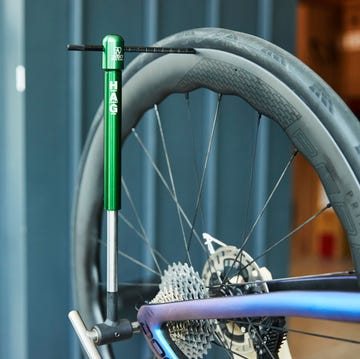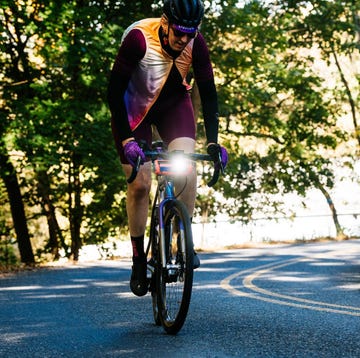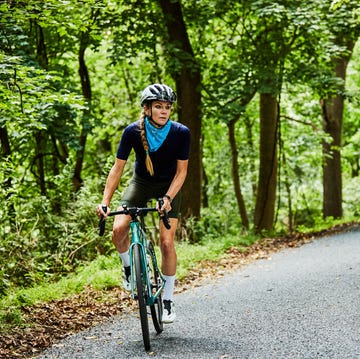A randonnée (pronounced rahn-doe-nay) is, by definition, a long bike ride that typically covers a distance of more than 100 miles. But randonnée-style “races” and the discipline of randonneuring as a form of cycling are a bit more nuanced than that.
The first rule of randonneuring is enjoying the ride—while also looking to push your personal limits. But that doesn’t mean comparing yourself to others. Rather, the focus in randonneuring is on how long your ride is, not how quickly you get to the end.
“The first friends I made in cycling just happened to be people who were doing big randonneuring rides,” Emily Chappell, one of the most well-known long-distance cyclists in the U.K., tells Bicycling. “Immediately, these people became my role models. I thought, ‘This is what cycling can look like’ and I wanted to be part of it.”
To delve deeper into randonneuring, we spoke to experts in long-distance cycling to gather their insights, tips, and essential how-tos for everything from fueling, hydration, and more.
What Exactly Is Randonneuring?
Randonneuring is simply defined as long-distance, unsupported endurance cycling. “This style of riding is non-competitive in nature, and self-sufficiency is paramount,” according to Randoneurs USA, the sanctioning body for randonneuring events in the United States. Randonnées generally cover many (many) miles of unpaved roads, though sometimes there’s some pavement mixed into the route.
While organized randonnée events do exist, they are “sport cycling” by nature and so there is typically no timing, podiums, or award money. Instead, think friendly camaraderie, not competition. Most randonnées are also a self-supported affair when it comes to mechanical issues riders may encounter during the ride.
So, is a gravel race like Unbound a randonnée? Not really. But the Flint Hills Ultra, which covers 1,000 miles of similar terrain and ends in Emporia, Kansas, right near where Unbound finishes? That’s a little more like it. The few who are brave enough to take part in it don’t really care about who wins, but rather, they care about just making it to the finish line.
Essential Randonneuring Training Tips
It’s a good idea to get a few practical considerations for spending an entire day on the bike ironed out before your long ride, like comfort in the saddle and your fueling and hydration strategy. The morning of the event isn’t the best time to realize that the new gel you’re trying upsets your stomach, or that you really dislike the taste of a new drink mix. And it’s definitely not the appropriate time to try a new saddle for the first time!
So before you set out for your first randonnée, follow these tips so you’re prepared for all those miles.
1. Figure Out Your Fueling
From mile one on your randonneuring adventure, food should be top of mind. It takes some trial and error to figure out what foods work best for you on these longer adventures. But you’re typically staying in zone 1 or 2—easy/endurance paces—so you’re often able to eat a wider variety of ride food than you would on a harder, shorter ride.
You may find that you need to alternate between traditional sports fuel like gels or bars and real food, like sandwiches, cheese and fruit, or even burritos, which are a favorite of Tyler Pearce, also known as the Vegan Cyclist, whose epically long adventures certainly put him in the category of a randonneur.
Eating frequently is also key: Don’t try to eat huge amounts all at once, you’ll have less gut issues if you eat smaller portions more often. Aim for the recommended 30 to 60 grams of carbohydrates per hour (at least!), and don’t be afraid to add foods with a bit of protein, like peanut butter sandwiches, if you’re out all day.
2. Dial in Your Hydration
“Drinking is super important,” says Chappell. “It’s incredible how quickly dehydration can negatively affect your ride. Drinking enough is one of the primary things you can do that will improve your performance the most.”
If you’re dehydrated, your power goes down, your cognition suffers, you can’t actually digest the food that you’re eating, Chappel explains.
To help you meet your nutrition goals, Chappel recommends setting your bike up with drinking and eating in mind. “Because you’re out all day, you know that you’ll hit a point where you’re tired and don’t want to expend energy getting your bottle. You also don’t want to crash trying to reach for snacks in a hard-to-reach pocket,” she says. “So think about where the easiest places to access on the bike are, and put your snacks there.”
Ease of drinking access is why many endurance cyclists have swapped from just using bottles on the bike to wearing hydration packs. Chappell also recommends bags that are easy to reach on your top tube for storing your snacks.
3. Cultivate the Right Mindset
“I really believe that if you can ride 60 miles without stopping, you can ride 1,000 miles,” Pearce tells Bicycling. “I know that sounds like it’s a huge jump, but if your body can comfortably withstand 60 miles, any distance beyond that really just becomes about pacing and fueling.”
When you’re riding a super long distance, Pearce says mindset becomes extremely important, too. Positive self-talk, in particular, is an important mental tool that you can expect to use a lot during a ride as long as a randonnée, especially as the miles start to feel long. This won’t just show up on event day though; you have to practice it throughout training so it becomes more of a default mindset.
Remember, too, that randonnées are about the long game, not the speed game. “You have to have the mindset of ‘I’m going to be done when I’m done.’ You can’t think about trying to finish by a certain time,” he says. You can practice this in training, too.
4. Learn How to Prevent Saddle Sores
You can’t talk about long-distance cycling without mentioning saddle sores. Unfortunately, the longer you ride, the more likely it is that you’ll end up with a saddle sore or some kind of irritation from a long time in the saddle. Prevention and aftercare of tender areas that make contact with the saddle is crucial.
“There isn’t a specific formula to prevent saddle sores,” says Chappell. “It’s so highly individualized. I try to think about it as a bunch of different small things that you have to dial in.”
Some of the small details that have an enormous effect on your comfort are making sure you have the right saddle for you, the right cycling shorts or bibs for you, the ideal position of your saddle, and whether chamois cream works well for you… or not. There are a lot of variables that are very personal to the rider, Chappell explains. To help figure out these variables, it’s important to get your setup as dialed in as possible on shorter rides ahead of your long-distance event.
Also, when you’re out on these long adventures, make sure that you’re regularly moving on the bike, standing up to take a few pedal strokes every few minutes to give your butt a break.
When you do finally finish your ride, get out of those bike shorts or bibs and get clean and dry down there ASAP! “Ideally, when you’re done riding, you’ll be in a private room, lying face down on the bed with no clothes on and a fan blowing over you,” laughs Chappell. “But if that is not possible, at the very least, wear a floaty skirt or something to let everything breathe!”
Tips for Riding a Successful Randonnée
1. Troubleshoot If You Feel Like Giving Up
As we mentioned earlier, finishing is winning in the world of randonneuring. But sometimes, you do have to hit the brakes. If you’re not injured or ill—which are great reasons to stop—Chappell suggests doing some troubleshooting before calling for pickup.
“Ask yourself: How long has it been since I’ve eaten? How long has it been since I had water? Have I stood up lately? Basically, you’re trying to troubleshoot any simple issues,” she says. While eating and drinking may sound obvious, when you’re getting tired after 10 or more hours on the bike, it’s hard to remember to sip your water and eat that snack.
If you are thinking of quitting, first eat and drink. If it’s an extremely long ride, Chappell also recommends taking a nap and changing your shorts. Then re-evaluate if you really want to end the ride, and pay attention to your self-talk to see if you’re simply talking yourself out of it, rather than physically feeling like you need to end.
Above all, listen to your body. “Do not be afraid to quit a ride if you need to: Everybody has to quit a ride at some point,” Chappell says. “You don’t get any prizes for pushing on when you’re damaged.”
2. Be Smart About Your Bike Computer
If your route will have you out for more than 10 hours and you’re relying on a cycling computer to give you turn-by-turn directions, make sure that your computer charge can handle that distance and duration.
Pearce uses the Coros Dura computer, which not only holds a charge for a long time, it also has a solar charger. As long as it’s a sunny day when you’re riding you’ll be powering as you pedal.
It’s always a good idea to have a backup plan in case your computer runs out of juice. When you’re going to be out all day, having a backup like the Strava app on your phone with your route loaded—plus a compact phone battery charger—can be a lifesaver. An old-school paper map is an easy, light, fail-safe thing to pack, too.
3. Don’t Accept Discomfort on the Bike
While saddle sores are hard to avoid entirely, Chappell says that you shouldn’t accept discomfort on the bike during your big ride. Instead, you should be constantly troubleshooting. Yes, some discomfort is inevitable the longer you ride, but a lot of it actually is avoidable—or at least, you can turn down the volume of the discomfort.
“My philosophy when I was doing ultra-distance races and rides was that I knew that things were going to go wrong. But the crucial thing was to not let them go too wrong,” Chappell says. “Because when everything is bad and you’re hungry and cold and wet and tired and you have saddle sores and a tiny thing goes wrong with your bike, you think, ‘Oh, hey, this is a really great excuse to quit.’
On the other hand, if you’ve been checking in with yourself, eating and drinking enough during the entire ride, taking that stretch break you needed, and have been shifting around on your bike to stay more comfortable, you’ll have higher mental reserves in the event that something goes awry. “In that case, it’s easier to find a mechanical issue frustrating, but not have it end your ride,” Chappell says.
3 Organized Randonnées to Consider
These organized or “planned” randonnées have an official depart like any bike race, but quickly become much more casual in terms of pacing. However, you’ll still likely have to check in at various stations on the route.
When you cross the line, it doesn’t matter if you’re first or last—you get your brevet (certificate that you finished). You can visit Randoneurs USA (RUSA) to see all of their approved rides in the U.S. But here are three popular ones:
1. Deerfield Dirt Road Randonnée (a.k.a. D2R2)
D2R2 is a Massachusetts staple—gravel before gravel was cool. It may not meet the RUSA guidelines of being 200 kilometers (the longest choice falls short by 20 kilometers), but they’re a really fun 180 kilometers.
The route uses the "narrowest, oldest, twistiest, quietest, and most-scenic roads available" in the area, and the vibe is all about fun and food. As the organizers say: “We never offer prizes for anything other than gags, nor will finish results ever be presented like it was a race.”
2. RAGBRAI (a.k.a. Register’s Annual Great Bicycle Ride Across Iowa)
This eight-day tour combines cycling huge distances with a festival atmosphere, and it’s the largest bike-touring event in the world. Founded in 1973, it recently celebrated its 50th anniversary and it’s still going strong.
3. Flint Hills Ultra
This event is 1,000 miles in Kansas that’s entirely self-paced and solo mission style. Riders can opt to ride through the night, camp roadside, or stay at hotels or Airbnbs along the route, as long as they stick to the planned route and eventually make it across the finish line. Sub-four track legend Ashton Lambie rode it in 2023, bringing some much-deserved attention to this cool event.

Molly writes about cycling, nutrition and training with an emphasis on bringing more women into sport. She's the author of nine books including the Shred Girls series and is the founder of Strong Girl Publishing. She co-hosts The Consummate Athlete Podcast and spends most of her free time biking and running on trails, occasionally joined by her mini-dachshund.













